Experts from the Center for Neurotechnology Research and Development at the South Federal University of Russia (SFU) have developed a hybrid AI-mouse biological system that can be used to identify substances in the air.
The accuracy of the AI-mouse hybrid biological system has improved from 60% to 100%, according to Gazeta.Ru, citing the “Priority 2030” program of the Ministry of Science and Higher Education of the Russian Federation.
So far, the ability of devices to detect odors has been very limited, as scientists have not been able to fully determine the composition of odor-causing substances and the principles of their effects on olfaction. Therefore, it was decided to combine electronic noses with biological noses.

In this hybrid biological system, mice act as sensors thanks to their sensitive sense of smell, and artificial intelligence (AI) will analyze the activity of the animal’s brain and provide results.
“Microelectrodes are implanted into the olfactory system of the mice. Next, the animal is placed under anesthesia and put into a box equipped with a biological signal amplifier. The computer program records the activity of the part of the brain responsible for olfaction, and the artificial neural network identifies the substance presented to the mouse,” said Dr. Piotr Kosenko.
“While under anesthesia, the olfactory brain functions much more effectively than in other states (awake or asleep). At the same time, we have observed that during deep anesthesia, the response of neurons increases and reaches maximum activity in the second hour, meaning during the deepest phase,” Piotr Kosenko added.
Such systems can be applied in various fields. For example, they could be used to detect potential hazardous substances, such as explosives or narcotics, as well as specific substances related to cancer found in the air exhaled by humans.
In the future, experts plan to create systems that operate continuously in real-time.


















































